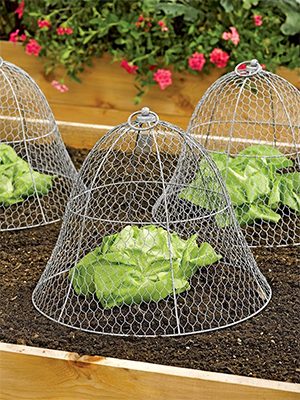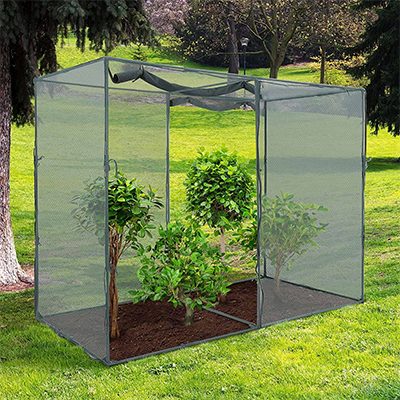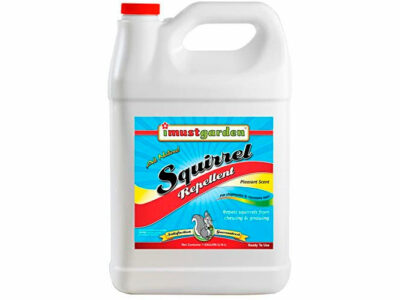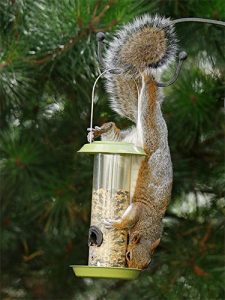Garden enthusiasts know the frustration of discovering squirrels have ravaged their carefully tended plants overnight. These persistent rodents dig up bulbs, eat vegetables and flowers, and bury food throughout garden beds. A squirrel proof garden cage creates an effective physical barrier between these destructive pests and your precious plants. This comprehensive guide explores various cage options—from DIY solutions to pre-made products—along with complementary strategies to keep squirrels out of your garden for good.
Quick Picks: Best Squirrel Proof Garden Cages

Best Single Plant

Best Full Garden

Best Cage Alternative
- Why You Need a Squirrel Proof Garden Cage
- Types of Squirrel Proof Garden Cages
- Individual Plant Squirrel Proof Cages
- Full Garden Squirrel Proof Cages
- DIY Squirrel Proof Garden Cage
- Complementary Squirrel Deterrent Methods
- Garden Layout Strategies for Squirrel Prevention
- Frequently Asked Questions
- Conclusion
Why You Need a Squirrel Proof Garden Cage
Squirrels may look cute scampering across your yard, but they can cause extensive damage to gardens in a short amount of time. Understanding the threats they pose helps highlight why protective cages are so valuable for gardeners.
Squirrels are particularly destructive during spring planting season and fall harvest, when they may dig up newly planted bulbs or steal ripening vegetables and fruits.
- Plant destruction Squirrels eat flower buds, seedlings, fruits, and vegetables, often taking just one bite before moving to the next plant.
- Excavation damage Their digging behavior can uproot young plants and damage root systems when they bury nuts and seeds for later retrieval.
- Bulb theft Freshly planted bulbs are particularly vulnerable, as squirrels can smell the disturbed soil and will dig them up to eat.
- Garden bed disruption The numerous small holes squirrels create throughout garden beds can disrupt careful landscaping and planting arrangements.
- Persistent returns Once squirrels discover your garden as a food source, they’ll return repeatedly, causing ongoing damage.
Types of Squirrel Proof Garden Cages
Garden cages come in various styles, each designed to address different protection needs. Understanding the options will help you select the right solution for your garden.
| Cage Type | Best For | Advantages | Considerations |
|---|---|---|---|
| Individual Plant Cloches | Protecting specific high-value plants or small garden areas | Easy to move, affordable, versatile placement | Limited coverage, requires multiple units for larger gardens |
| Raised Bed Cages | Raised garden beds with vegetables or flowers | Custom fit, good access through hinged tops | Requires assembly, limited to raised bed dimensions |
| Full Garden Enclosures | Complete protection for larger garden areas | Comprehensive protection, walk-in access | More expensive, complex installation, permanent structure |
| Protection Tents | Seasonal protection for garden sections | Portable, easy setup/takedown, affordable | Less durable than permanent structures, limited size options |
| DIY Garden Cages | Custom solutions for unique garden layouts | Fully customizable, can be built to exact specifications | Requires tools and construction skills, time-intensive |
Individual Plant Squirrel Proof Cages
For targeted protection of specific plants or small groups of plants, individual cages offer an affordable and flexible solution. These are particularly useful for protecting high-value specimens or newly planted bulbs that are especially attractive to squirrels.
Gardener's Supply Company Sturdy Chicken Wire Cloche Plant Protector
Best Single Plant ProtectionHow Does It Work
How to Use
- Place the cloche directly over the plant you want to protect
- Press the legs firmly into the soil for stability
- For added security, use garden stakes to anchor the cloche in windy conditions
- Access your plant by lifting the entire cloche or removing the top section
- For newly seeded areas, place the cloche before germination for continuous protection
- Attractive design adds decorative element to gardens
- Durable powder-coated finish prevents rusting
- Easy access to plants for maintenance and harvesting
- Provides protection while allowing proper sunlight and water penetration
- Reusable season after season
- Limited to protecting one plant or small plant group per cloche
- May not be tall enough for mature plants depending on variety
- More expensive than DIY chicken wire solutions
Other Effective Individual Plant Cage Options
Wire Garden Cloches
Wire cloches with smaller mesh openings (½ inch or less) provide excellent protection for individual plants while still allowing adequate air circulation and water penetration.
Pop-Up Mesh Covers
Lightweight, collapsible mesh covers are perfect for seasonal protection of small plant groupings and can be easily stored when not in use.
Row Covers with Supports
For vegetable gardens, hooped row covers with secured edges provide protection while allowing easy access for harvesting and maintenance.
Full Garden Squirrel Proof Cages
When individual plant protection isn’t sufficient, full garden enclosures provide comprehensive protection for larger planting areas. These solutions are ideal for vegetable gardens, ornamental beds, or any area experiencing persistent squirrel problems.
GROWNEER 4 x 8 Feet Crop Cage Plant Protection Tent
Best Full Garden SolutionHow Does It Work
How to Use
- Select a level area that receives appropriate sunlight for your plants
- Assemble the frame according to included instructions
- Position the tent over your garden bed or container garden
- Secure the ground tubes firmly into the soil
- Use the zippered door for garden maintenance and harvesting
- Large 32 square foot coverage area protects multiple plants
- Easy assembly requires no tools
- Fine mesh keeps out pests while allowing sunlight and water
- Zippered door provides convenient access
- Portable design can be moved as needed
- May not stand up to severe weather conditions
- Height might limit some taller plants
- Requires periodic inspection for tears or damage
DIY Squirrel Proof Garden Cage
Building your own garden cage allows for complete customization to fit your specific garden layout and protection needs. While requiring more time and effort than pre-made solutions, DIY cages can be tailored to exact specifications and often prove more cost-effective for larger areas.
Before beginning construction, check local building codes or HOA regulations that might impact the size, height, or appearance of your garden cage structure.
Step-by-Step DIY Garden Cage Construction

Materials Needed
- Pressure-treated 4×4 posts (corner supports)
- Pressure-treated 2×4 lumber (framing)
- Galvanized screws
- Quick-setting concrete
- Hinges and door latch (for access door)
- ½” hardware cloth or chicken wire
- Galvanized staples
- Wire cutters
- Zip ties (for securing seams)
- Gravel for base trench (optional)
- Post hole digger
- Circular saw or miter saw
- Power drill with driver bits
- Level
- Measuring tape
- Staple gun (heavy duty)
Construction Process
- Plan and measure your garden area Create a detailed diagram of your garden with exact measurements for length, width, and desired height (typically 6-8 feet to allow comfortable access).
- Set corner posts Dig holes 2 feet deep at each corner. Position 4×4 posts, check for plumb with a level, and secure with quick-setting concrete.
- Install intermediate posts For spans longer than 8 feet, add additional posts between corners. Space posts no more than 8 feet apart for proper support.
- Add bottom framing Attach 2×4 lumber horizontally along the bottom perimeter between all posts. This creates the base frame.
- Create top frame Install 2×4 lumber horizontally across the tops of all posts to complete the upper frame.
- Add middle support Place horizontal 2x4s midway between top and bottom on all sides except where your door will be located.
- Build and install door Construct a frame door using 2x4s with a center cross-support. Attach with hinges and add a latch mechanism.
- Attach hardware cloth Starting from the bottom, wrap hardware cloth around the entire perimeter, stapling securely to the wooden frame every few inches.
- Secure roof covering Cover the top frame with hardware cloth, overlapping and securing to the frame with staples.
- Reinforce vulnerable areas Pay special attention to corners, seams, and the door frame, adding extra staples or wire to prevent gaps.
For maximum protection against digging squirrels, dig a 6-inch trench around the perimeter of your cage. Extend the hardware cloth into this trench and backfill with gravel before attaching to the bottom frame. This creates an underground barrier that prevents squirrels from tunneling under your cage.
Complementary Squirrel Deterrent Methods
While garden cages provide excellent physical protection, combining them with additional deterrent methods creates a more comprehensive defense against persistent squirrels.
I Must Garden Squirrel Repellent
Best Natural RepellentHow Does It Work
How to Use
- Shake well before using to ensure proper mixing of ingredients
- Spray directly on plants, garden borders, and areas of squirrel activity
- Apply to dry surfaces for best adhesion and lasting protection
- Reapply every 2-4 weeks or after heavy rainfall
- For areas with intense squirrel pressure, apply more frequently
- Contains only natural ingredients safe for plants, people, and pets
- No harmful chemicals, poisons, or toxic substances
- Pleasant scent for humans but deterrent for squirrels
- Can be applied directly to plants, including vegetables and flowers
- Complements physical barriers for enhanced protection
- Requires regular reapplication, especially after rain
- May not deter extremely persistent squirrels on its own
- Works best as part of an integrated approach rather than sole solution
Natural Repellent Strategies
Enhance your garden cage protection with these natural deterrents that make your garden less appealing to squirrels:
Natural Squirrel Deterrents
- Predator urine: Products containing fox or coyote urine create the impression that predators are nearby, triggering squirrels’ natural avoidance instincts.
- Aromatic plants: Incorporate strong-smelling plants like mint, garlic, onions, and marigolds throughout your garden as natural repellents.
- Hot pepper spray: A homemade solution of hot peppers steeped in water creates a spicy deterrent that can be sprayed on non-edible plants.
- Coffee grounds: Sprinkling used coffee grounds around plants creates an odor barrier that many squirrels avoid.
- Blood meal fertilizer: This nitrogen-rich fertilizer doubles as a squirrel deterrent due to its strong scent that suggests predator presence.
Garden Layout Strategies for Squirrel Prevention
Beyond physical barriers and repellents, thoughtful garden design can significantly reduce squirrel attraction and damage:
| Strategy | Implementation | Benefits |
|---|---|---|
| Strategic Plant Selection | Include squirrel-resistant plants like daffodils, hyacinths, alliums, and fritillarias | Naturally deters squirrels due to toxic or unpalatable compounds in these plants |
| Decoy Feeding Stations | Place feeding stations with nuts and seeds far from garden areas | Diverts squirrel activity away from valuable plants |
| Companion Planting | Surround vulnerable plants with strong-smelling herbs and flowers | Creates natural sensory barriers that mask attractive scents |
| Garden Cleanup | Promptly remove fallen fruits, nuts, and garden debris | Reduces food sources that attract and reward squirrel visits |
| Tree Management | Trim tree branches that extend over garden areas | Eliminates aerial access routes to gardens |
Never use poisons or harmful chemicals to control squirrels. These can affect non-target wildlife, pets, and potentially contaminate your garden. Additionally, poisoning squirrels is illegal in many jurisdictions. Always use humane deterrent methods that focus on exclusion rather than harm.
Frequently Asked Questions
What size mesh is best for squirrel-proof garden cages?
For effective squirrel exclusion, use mesh with openings no larger than ½ inch (1.27 cm). Squirrels can squeeze through surprisingly small spaces—adult squirrels can fit through holes as small as 1.5 inches in diameter. Hardware cloth with ½-inch or ¼-inch openings provides the best protection, as chicken wire with 1-inch hexagonal openings may allow smaller juvenile squirrels to squeeze through.
Additionally, ensure the mesh is made from galvanized steel rather than plastic, as squirrels can easily chew through plastic or vinyl materials. The heavier gauge of the wire (lower gauge number), the more durable and squirrel-resistant your cage will be.
How tall should a garden cage be to keep squirrels out?
A garden cage should be at least 4 feet tall to prevent squirrels from jumping over it, though 6-8 feet is ideal for complete protection and human accessibility. Squirrels can jump vertically up to 4 feet and can leap horizontally up to 10 feet when jumping from an elevated position.
If your garden is near trees, fences, or structures that could serve as launching points, either make your cage taller or ensure it has a secure top covering to prevent squirrels from jumping onto and then into the enclosure. For maximum protection, include a covered top regardless of height, as squirrels are excellent climbers.
Do garden cages harm plant growth by blocking sunlight?
Properly designed garden cages have minimal impact on plant growth when using appropriate materials. Wire mesh with ½-inch or ¼-inch openings allows approximately 85-90% light transmission, which is sufficient for most plants. For optimal growth, use galvanized hardware cloth or chicken wire rather than plastic netting, which can deteriorate in UV light and create more shade.
If growing particularly light-sensitive plants, consider using a cage with a removable or hinged top that can be opened during portions of the day when squirrel activity is lowest. Some gardeners also install clear polycarbonate panels on the top surface for maximum light penetration while maintaining protection.
How do I access my plants inside a garden cage?
Well-designed garden cages should include an access point for gardening activities. For smaller cages, this might be a hinged or removable top section. For larger walk-in enclosures, incorporate a door frame with a secure latching mechanism that prevents squirrels from pushing it open.
When designing your cage, consider the frequency of access needed and plan accordingly. For gardens requiring daily attention, a full-height door is ideal. For seasonal plantings that need less frequent maintenance, a hinged panel might be sufficient. Whatever design you choose, ensure all access points close securely and have no gaps larger than ½ inch that would allow squirrels to enter.
Are there any plants squirrels won’t eat that I can grow outside a cage?
While no plant is 100% squirrel-proof, there are many that squirrels typically avoid due to toxic properties, strong scents, or unpalatable textures. Daffodils, alliums, hyacinths, and fritillaria contain compounds toxic to squirrels and are rarely disturbed. Strongly aromatic herbs like mint, rosemary, lavender, and sage are generally avoided due to their potent oils.
Other squirrel-resistant options include foxglove, lily of the valley, geraniums, hellebores, and euphorbias. However, during times of food scarcity, extremely hungry squirrels may attempt to eat even these resistant plants, so monitoring is still necessary. For absolutely guaranteed protection of vulnerable plants, physical barriers remain the most reliable solution.
Conclusion
A squirrel proof garden cage represents one of the most effective and humane solutions for protecting your plants from these persistent rodents. Whether you choose individual plant cloches, full garden enclosures, or construct a custom DIY solution, physical barriers provide reliable protection that chemical deterrents alone cannot match.
For optimal results, implement a multi-layered approach that combines:
- Physical barriers like properly constructed garden cages with appropriate mesh size
- Natural repellents such as predator urine or botanical oil sprays
- Strategic garden design incorporating squirrel-resistant plants and limited access points
- Regular maintenance of your protective structures and garden areas
With these protective measures in place, you can enjoy the fruits of your gardening labor without sharing your harvest with squirrels. The initial investment in time and materials for garden cage construction will quickly pay dividends in preserved plants, undisturbed garden beds, and the satisfaction of successfully outwitting these clever garden pests.



